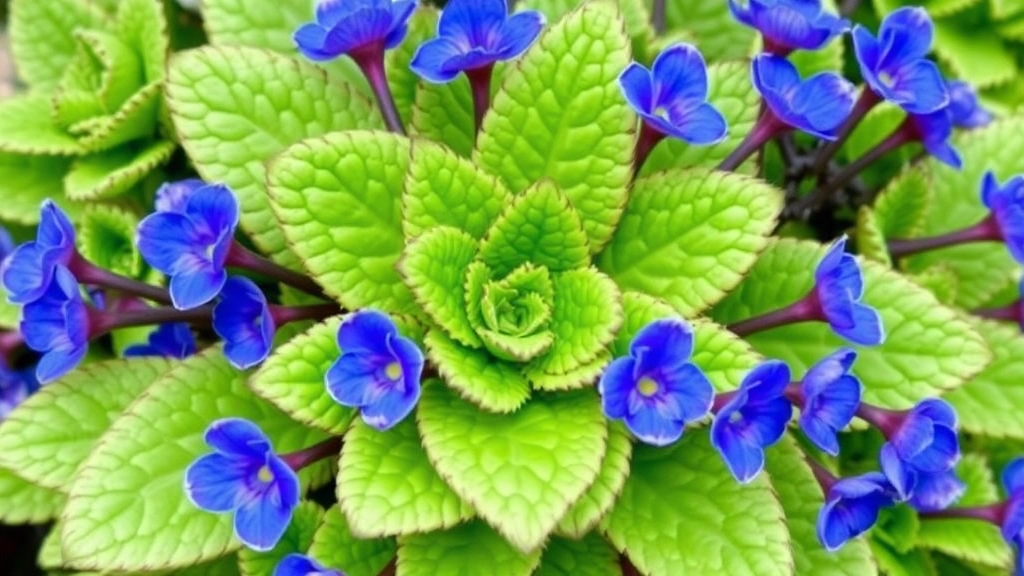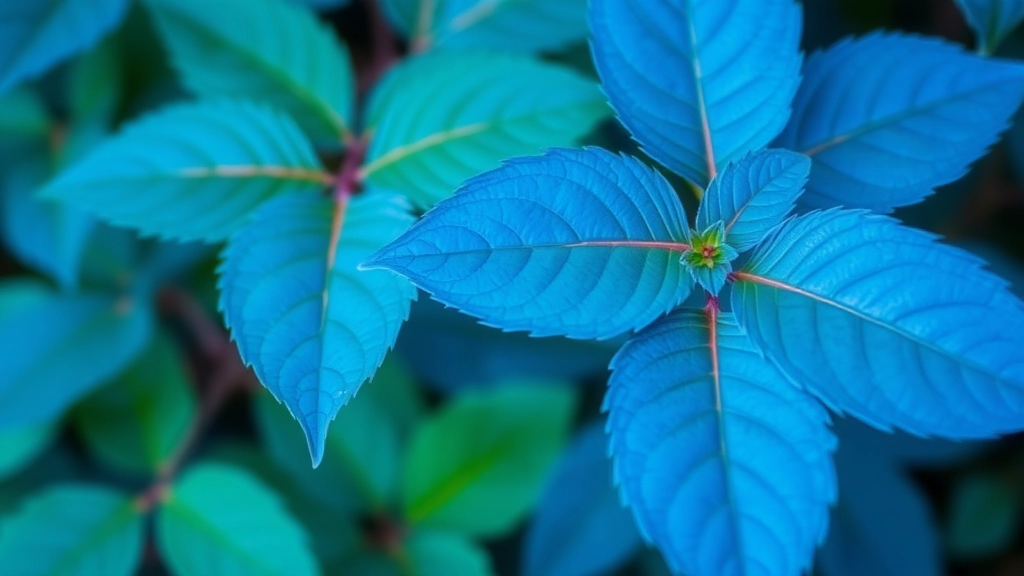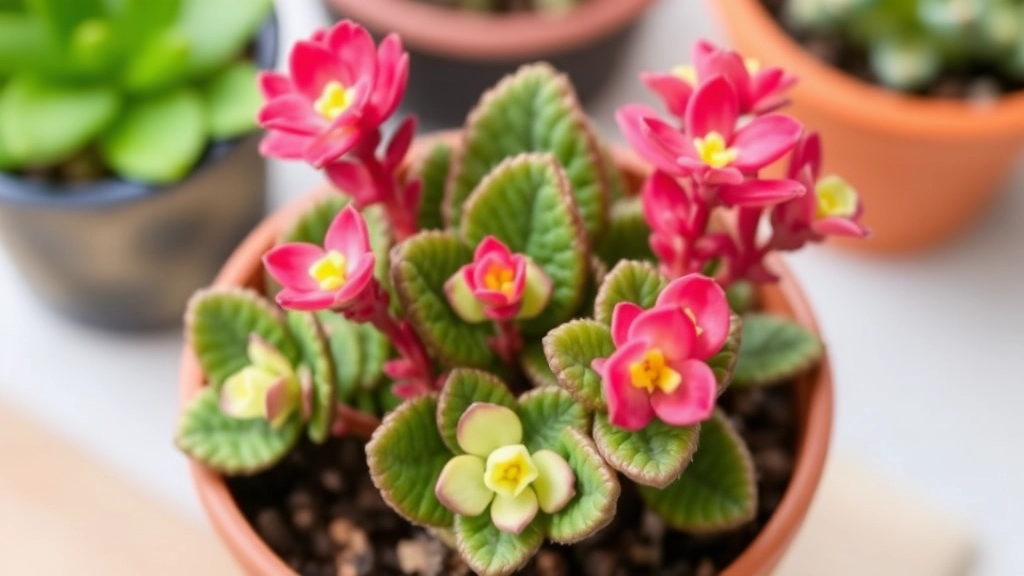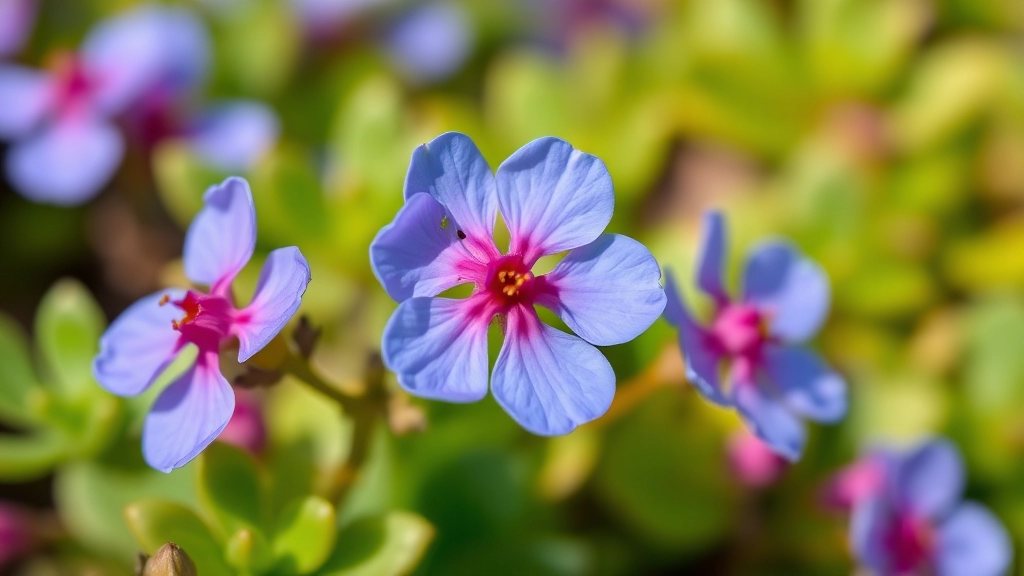Blue Kalanchoe Flower
When it comes to unique and eye-catching succulents, the Blue Kalanchoe Flower stands out. Known for its bluish or grayish leaves, this plant is a favourite among gardeners looking to add a touch of elegance to their indoor or outdoor spaces. Whether you’re a seasoned gardener or a succulent newbie, understanding the various types of Blue Kalanchoe and their care requirements is essential for thriving plants.
Optimal Growing Conditions
Optimal growing conditions are crucial for the Blue Kalanchoe Flower. These succulents thrive in well-draining soil and require minimal watering, making them perfect for drought-tolerant gardens. Adequate light and temperature also play a significant role in maintaining their vibrant blue hues. Learn the best practices for soil, watering, light, and temperature to ensure your Blue Kalanchoe remains healthy and beautiful.
Types of Blue Kalanchoe Varieties
When considering adding Blue Kalanchoe to your collection, you might wonder about the different varieties available. Each type offers unique characteristics that cater to various preferences and needs.
1. Kalanchoe thyrsiflora (Paddle Plant)
This variety is well-known for its striking blue-green leaves that resemble paddles.
- Leaf Shape: Thick, rounded leaves.
- Height: Can grow up to 1 metre tall.
- Flowers: Produces bright yellow flowers in clusters.
2. Kalanchoe luciae (Flapjack Plant)
Another popular choice, the Flapjack Plant showcases vibrant blue leaves with a hint of red at the edges.
- Leaf Shape: Flat, succulent leaves that stack.
- Height: Typically reaches around 30-60 cm.
- Flowers: Small, tubular flowers that are usually red or yellow.
3. Kalanchoe beharensis (Elephant Ear Plant)
This variety boasts large, textured leaves with a blue-grey tint.
- Leaf Shape: Broad and slightly wavy.
- Height: Can grow up to 1.5 metres tall.
- Flowers: Produces tall spikes of small, tubular flowers.
4. Kalanchoe tomentosa (Panda Plant)
While not entirely blue, the Panda Plant features fuzzy, blue-grey leaves with brown edges, making it a delightful addition.
- Leaf Shape: Thick, fuzzy leaves.
- Height: Generally stays under 30 cm.
- Flowers: Produces small, tubular flowers in a pale yellow hue.
Each of these varieties brings its own flair to the table, making it essential to choose one that aligns with your aesthetic and care preferences. For more in-depth care tips, you might want to check out this complete guide on caring for Kalanchoe Flapjack Flowers and the care tips for Kalanchoe Beharensis.
Optimal Growing Conditions for Blue Kalanchoe

So, you’ve got your eye on a beautiful Blue Kalanchoe, but how do you ensure it thrives?
Let’s dive into the optimal growing conditions that will make your succulent shine.
Temperature Matters
- Ideal Range: Blue Kalanchoes love warmth. Keep them in temperatures between 18°C to 24°C (65°F to 75°F).
- Avoid Frost: They aren’t fans of the cold. Protect them from temperatures below 10°C (50°F) to prevent damage.
Humidity Levels
- Low Humidity: These succulents prefer dry air. Aim for humidity levels below 50%.
- Airflow: Good ventilation helps prevent rot and keeps your plant happy.
Potting Position
- Indoors or Outdoors: Blue Kalanchoes can thrive both indoors and outdoors, but they need the right spot.
- Container Choice: Use a pot with drainage holes to avoid waterlogging. Terra cotta pots are a great option as they help wick away moisture.
Seasonal Adjustments
- Growing Season: Spring and summer are prime times for growth. During these months, you might notice your plant blooming with vibrant flowers.
- Dormancy: In winter, reduce watering as the plant goes dormant. It’s a time for rest, so don’t stress if it looks less lively.
Fertilising Tips
- Feeding Schedule: Fertilize during the growing season every 4-6 weeks with a balanced, water-soluble fertiliser.
- Dilution: Always dilute the fertiliser to half strength to avoid burning the roots.
Soil and Watering Requirements for Succulent Success
When it comes to cultivating Blue Kalanchoe, understanding its soil and watering requirements is vital for ensuring robust growth and vibrant foliage. Many new plant enthusiasts often wonder, âWhat type of soil is best for my Blue Kalanchoe?â or âHow often should I water it?â Let’s delve into these essential aspects.
Soil Composition
Blue Kalanchoe thrives in well-draining soil, which is crucial for preventing root rot. Here are some key points to consider:
- Cactus Mix: A pre-mixed cactus or succulent soil is ideal, as it provides excellent drainage.
- Homemade Blend: If you prefer a DIY approach, combine:
- 50% potting soil
- 25% perlite
- 25% coarse sand
- pH Level: Aim for a slightly acidic to neutral pH (6.0 to 7.0) for optimal growth.
Watering Guidelines
Watering Blue Kalanchoe can be tricky, especially for those new to succulent care. The general rule of thumb is to let the soil dry out completely between waterings. Here are some practical tips:
Light and Temperature Needs for Vibrant Blue Leaves

When it comes to nurturing your Blue Kalanchoe, understanding its light and temperature requirements is crucial for achieving those stunning, vibrant blue leaves.
Light Requirements
Blue Kalanchoes thrive in bright, indirect sunlight. Here are some key points to consider:
- Direct Sunlight: While they can tolerate a few hours of direct sunlight, too much can scorch their leaves.
- Indirect Light: A spot near a window with filtered light is ideal. This ensures they receive enough energy without the risk of sunburn.
- Artificial Light: If natural light is limited, consider using grow lights to supplement their needs.
Temperature Needs
Temperature plays a significant role in the health of your Blue Kalanchoe.
- Ideal Range: They prefer temperatures between 15°C and 25°C.
- Avoid Extremes: Keep them away from cold drafts and extreme heat. Temperatures below 10°C can be detrimental.
- Seasonal Changes: During winter, ensure they are kept in a warmer environment, as they are sensitive to frost.
In essence, providing the right light and temperature conditions will ensure your Blue Kalanchoe flourishes beautifully.
As we delve into the world of Blue Kalanchoe care, it’s essential to address a pressing concern: pests.
### Common Pests
Blue Kalanchoes, like many succulents, can be susceptible to a variety of pests. The most common ones include:
– **Mealybugs**: These small, white, cotton-like insects can cluster in leaf axils and on stems. They suck sap from the plant, leading to wilting.
– **Spider Mites**: Tiny and often invisible, spider mites can cause speckled leaves and webbing, particularly in dry conditions.
– **Aphids**: These small, green or black insects can be found on new growth, sucking sap and causing distortion.
– **Scale Insects**: These pests appear as small, raised bumps on stems and leaves. They also feed on sap, weakening the plant.
### Treatment Options
Fortunately, there are effective methods to combat these pests and keep your Blue Kalanchoe thriving:
1. **Manual Removal**: For mealybugs and scale, use a cotton swab dipped in rubbing alcohol to remove them directly from the plant.
2. **Insecticidal Soap**: This is a safe option for treating a variety of pests. Spray it on affected areas, ensuring thorough coverage.
3. **Neem Oil**: A natural pesticide, neem oil disrupts the life cycle of pests. Mix it with water and spray it on the plant, avoiding direct sunlight to prevent leaf burn.
4. **Diatomaceous Earth**: Sprinkling this powder around the base of your plant can deter crawling insects without harming your Kalanchoe.
5. **Regular Inspection**: Make it a habit to check your plants weekly. Early detection can save your Kalanchoe from severe infestations.
For more detailed care tips, check out our [Blue Kalanchoe Flower Care Guide](https://planthq.org/blue-kalanchoe-flower-care-varieties-and-uses/) and explore our [Outdoor Kalanchoe Care Tips](https://planthq.org/outdoor-kalanchoe-care-expert-tips-and-best-practices/) for expert advice on maintaining healthy plants.
Propagation Techniques for Kalanchoe Varieties

So, you’re keen on expanding your Blue Kalanchoe collection?
Propagation is a fantastic way to do just that. It’s not only rewarding but also a fun project. Let’s dive into how you can easily propagate these beauties.
1. Leaf Cuttings
- Choose a Healthy Leaf: Pick a plump, healthy leaf from your Kalanchoe.
- Cut It Off: Use clean scissors or a knife to snip it off at the base.
- Let It Callous: Place the leaf in a dry spot for a few days to allow the cut end to callous over. This helps prevent rot.
- Plant It: Once it’s calloused, place it in well-draining soil and lightly water it.
- Keep It Moist: Mist the soil occasionally, but don’t overwater.
2. Stem Cuttings
- Select a Stem: Look for a healthy stem with a few leaves.
- Cut and Prepare: Cut just below a leaf node and let it dry for a day or two.
- Plant: Insert the cut end into soil, ensuring it’s upright.
- Water Sparingly: Again, mist lightly and keep the soil slightly moist.
3. Offsets
- Look for Offsets: Some Kalanchoe varieties produce small offsets (baby plants) at the base.
- Gently Remove: Carefully detach the offset from the parent plant.
- Plant: Place it in its own pot with well-draining soil.
- Water Lightly: Just enough to settle the soil.
4. Seed Propagation
- Collect Seeds: If your Kalanchoe flowers, you can collect seeds.
- Sow: Sprinkle them on the surface of moist soil and lightly cover them.
- Keep Warm: Place in a warm spot and mist regularly.
Propagation can be a bit of a waiting game, but with a little patience, you’ll soon have new plants to admire.
When considering the ideal companions for your Blue Kalanchoe, it’s essential to think about their specific needs and how other plants can enhance their growth.
Choosing the right companion plants can elevate the aesthetic of your garden while ensuring a harmonious environment. Here are some excellent options:
– **Aloe Vera**: This succulent thrives in similar conditions, making it a perfect match for Blue Kalanchoes. Both plants enjoy well-draining soil and infrequent watering.
– **Echeveria**: Known for its stunning rosettes, Echeveria pairs beautifully with Blue Kalanchoes. They share light and temperature preferences, creating a cohesive look.
– **Sedum**: This hardy succulent offers a variety of textures and colours, complementing the vibrant blue leaves of Kalanchoes. Sedums are drought-tolerant and thrive in similar conditions.
– **Agave**: With its dramatic form, Agave can serve as a striking backdrop for Blue Kalanchoes. Both plants appreciate bright light and minimal watering.
– **Haworthia**: These small, attractive succulents are low-maintenance and can thrive alongside Blue Kalanchoes, adding diversity without overwhelming the space.
### Benefits of Companion Planting
– **Pest Control**: Certain companion plants can deter pests that may affect your Kalanchoes.
– **Aesthetic Appeal**: Combining different shapes and colours can enhance the visual interest of your garden.
– **Microclimate Creation**: Some plants can provide shade or humidity, benefiting your Kalanchoes.
By choosing the right companions, you can create a thriving, beautiful garden that showcases your Blue Kalanchoe to its fullest potential. For more detailed care tips, you can check out the [complete guide to Kalanchoe plant care](https://planthq.org/complete-guide-to-kalanchoe-plant-care/) and learn about [how to care for Kalanchoe succulents](https://planthq.org/how-to-care-for-kalanchoe-succulent-ultimate-guide/).
Best Indoor and Outdoor Uses of Blue Kalanchoe
So, you’ve got your stunning Blue Kalanchoe, and now you’re wondering where to showcase this beauty?
Let’s dive into the best indoor and outdoor uses for your vibrant succulent.
Indoor Uses for Blue Kalanchoe
- Table Centerpiece:
- A Blue Kalanchoe makes a fantastic focal point on your dining or coffee table.
- Pair it with other succulents for a mini garden vibe.
- Window Sills:
- These plants thrive in bright light, making window sills the perfect spot.
- Just ensure they’re not in direct harsh sunlight all day.
- Office Desk:
- Brighten up your workspace with a cheerful Blue Kalanchoe.
- It’s said that having plants around can boost your mood and productivity.
- Bathroom Decor:
- The humidity in bathrooms can be great for these succulents.
- Just place it near a window for some natural light.
Outdoor Uses for Blue Kalanchoe
- Garden Borders:
- Use Blue Kalanchoe to line pathways or garden borders.
- Their unique colour adds a pop against green foliage.
- Patio Planters:
- Perfect for container gardening, they thrive in pots on your patio.
- Mix them with other drought-tolerant plants for a stunning display.
- Rock Gardens:
- Their low-growing nature makes them ideal for rock gardens.
- They can fill in gaps beautifully and require minimal maintenance.
- Hanging Baskets:
- Create an eye-catching hanging display with trailing varieties.
- The blue leaves cascading down can be quite the showstopper.
Why Choose Blue Kalanchoe?
- Low Maintenance:
- They’re perfect for busy folks or those new to gardening.
- A little water and light, and they’re happy!
- Versatile:
- Whether indoors or outdoors, these plants fit right in.
- Their unique colour adds flair anywhere.
For more detailed care tips, you might want to check out our complete guide on caring for Kalanchoe succulents. Additionally, if you’re interested in growing Kalanchoe outdoors, our expert guide for outdoor Kalanchoe growing has all the information you need.
FAQs About Blue Kalanchoe Flower
What are the ideal temperature conditions for Blue Kalanchoe?
Blue Kalanchoes thrive in temperatures between 18°C to 24°C (65°F to 75°F). It’s important to protect them from temperatures below 10°C (50°F) to prevent damage.
How much humidity do Blue Kalanchoes need?
These succulents prefer low humidity levels, ideally below 50%. Good ventilation is also crucial to prevent rot and keep the plant healthy.
Where should I place my Blue Kalanchoe?
Blue Kalanchoes can be kept both indoors and outdoors. Ensure they are placed in a well-ventilated spot with a pot that has drainage holes to avoid waterlogging. Terra cotta pots are recommended.
How should I adjust care for Blue Kalanchoe seasonally?
During the growing season (spring and summer), expect vibrant blooms and increase watering. In winter, reduce watering as the plant goes dormant, allowing it to rest.
What are the light requirements for Blue Kalanchoe?
Blue Kalanchoes thrive in bright, indirect sunlight. They can tolerate a few hours of direct sunlight but too much can scorch their leaves. If natural light is limited, consider using grow lights.
How often should I fertilize my Blue Kalanchoe?
Fertilize during the growing season every 4-6 weeks with a balanced, water-soluble fertilizer diluted to half strength to avoid burning the roots.
What are the best methods for propagating Blue Kalanchoe?
There are several methods to propagate Blue Kalanchoe:
- Leaf Cuttings: Choose a healthy leaf, let it callous, then plant it in well-draining soil.
- Stem Cuttings: Select a healthy stem, let it dry, and then plant it upright in soil.
- Offsets: Remove small offsets from the base of the parent plant and place them in their own pots.
- Seed Propagation: Collect seeds from flowers, sow them on moist soil, and keep them warm.
Can Blue Kalanchoe tolerate extreme temperatures?
Blue Kalanchoes prefer temperatures between 15°C and 25°C. They should be kept away from cold drafts and extreme heat, as temperatures below 10°C can be detrimental.
How often should I water my Blue Kalanchoe?
During the growing season, water regularly but ensure the soil is well-draining to prevent waterlogging. In winter, reduce watering as the plant enters dormancy.
Can Blue Kalanchoe be grown indoors?
Yes, Blue Kalanchoes can thrive indoors if placed in a spot with bright, indirect sunlight and good ventilation. Using a pot with drainage holes is essential to avoid waterlogging.
References
-
How to Grow Kalanchoe Indoors
-
Kalanchoe Care: Growing and Caring for Kalanchoe
-
Kalanchoe: How to Grow and Care for Kalanchoe
